Context
Recently, the 2024 Global Report on Food Crisis (GRFC) has been launched by the Global Network Against Food Crises.
- Recently, the World Bank said that it was providing $57.6 million in “quick release” grant financing to Malawi to help the country respond to a food crisis.
| Relevance For Prelims: Food Security, Nutritional Security In India, India’s Food & Nutrition Security, Global Hunger Index 2023, Food Waste Index Report 2024 By UNEP, State Food Safety Index (SFSI) 2023, and Recent Food Inflation In India.
Relevance For Mains: Global Food Crisis: Status, Key Components, Challenges, Initiatives, and Way Forward. |
About Global Report on Food Crisis
The Global Report on Food Crisis (GRFC) is the reference document for a comprehensive analysis of global, regional and country-level acute food insecurity.
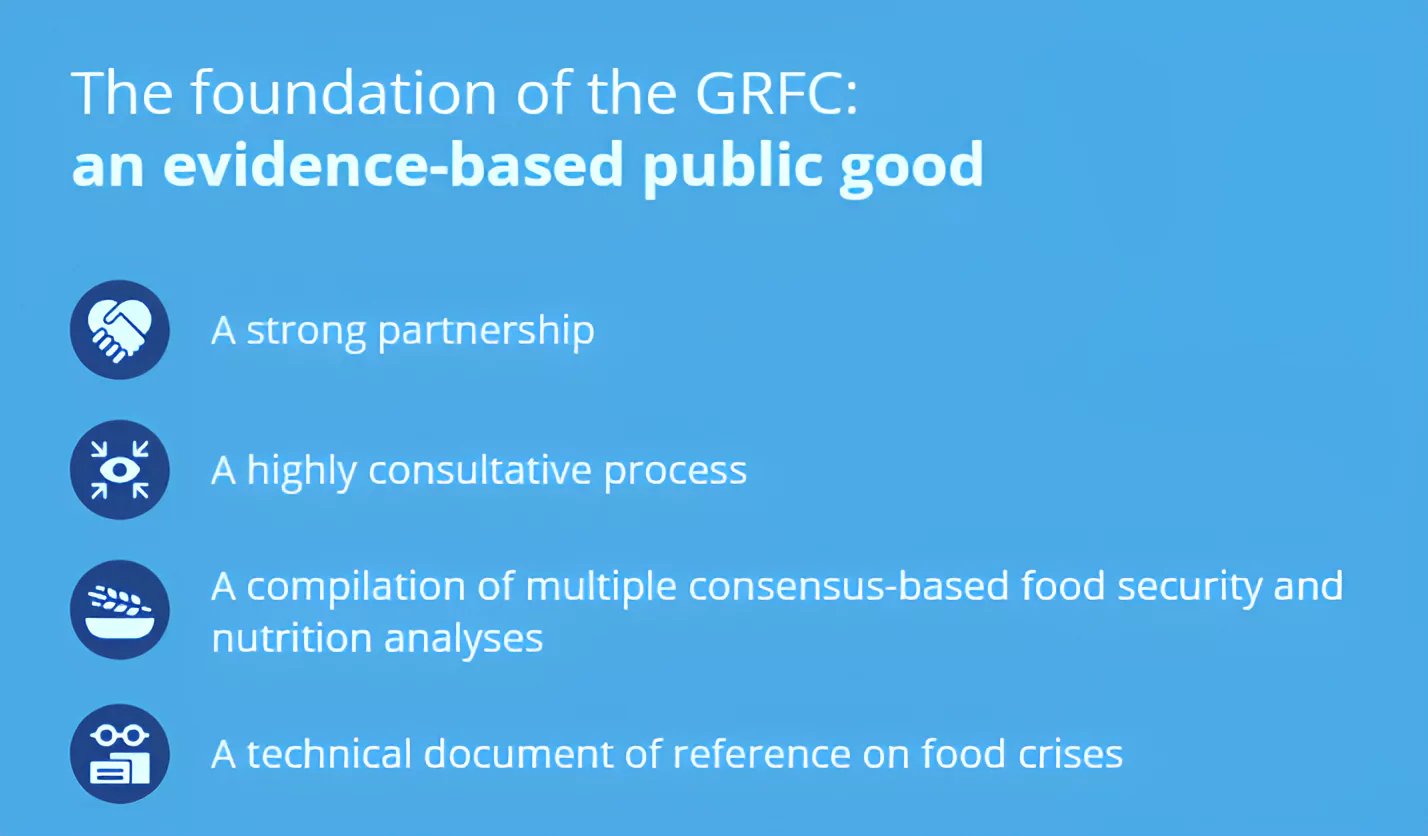
- Aim: To inform humanitarian and development action by providing independent and consensus-based evidence and analysis.
- Measurement: When it comes to estimating hunger, there are different measures for different purposes. The GRFC focuses on acute food insecurity in countries experiencing food crises. It is part of an annual suite of products including regional reports.
- The report analysed a population of 1.3 billion in 2023 across 59 countries.
- Food Crisis: The GRFC defines a food crisis as a situation where acute food insecurity requires urgent action to protect and save lives and livelihoods at local or national levels and exceeds the local resources and capacities to respond.
- Acute Food Insecurity: It refers to a situation in which populations face food deprivation that threatens their lives or livelihoods, regardless of the causes, context or duration.
- A food crisis is defined as ‘major’ if more than 1 million people or more than 20% of its total county population is estimated to be facing Phase 3 Crisis or above, or if at least one area is classified in Phase 4 Emergency or above.
- Action becomes a matter of life or death when the situation is particularly severe, such as in IPC/CH Phases 3, 4 or 5.
- Integrated Food Security Phase Classification (IPC): IPC is a standardized scale developed by the United Nations Food and Agriculture Organization for improving food security analysis and decision making.
- The IPC Integrated Food Security Phase Classification System indicates five phases of Acute Food Insecurity: Minimal, Stressed, Crisis, Emergency and Catastrophe when Famine may be declared.
Enroll now for UPSC Online Course
- A global initiative co-sponsored by Food and Agriculture Organization (FAO), World Food Programme (WFP) and International Food Policy Research Institute (IFPRI).
- Aim: To strengthen food and nutrition security information systems for producing reliable and accurate data to guide analysis and decision-making.
Global Report on Food Crisis (GRFC):
- It is produced annually by the Food Security Information Network and launched by the Global Network Against Food Crises – a multistakeholder initiative that includes United Nations agencies, the European Union, the United States Agency for International Development and non-governmental agencies working to tackle food crises
Integrated Food Security Phase Classification (IPC):
- An IPC analysis published in March 2024 warned of a further devastating deterioration, with famine imminent between March and May 2024 in North Gaza and a risk of famine across the rest of the Gaza Strip.
- Half of the population (about 1.1 million people) were estimated to be experiencing catastrophic acute food insecurity (IPC Phase 5).
|
Crucial Insights of the 2024 Global Report on Food Crisis (GRFC)
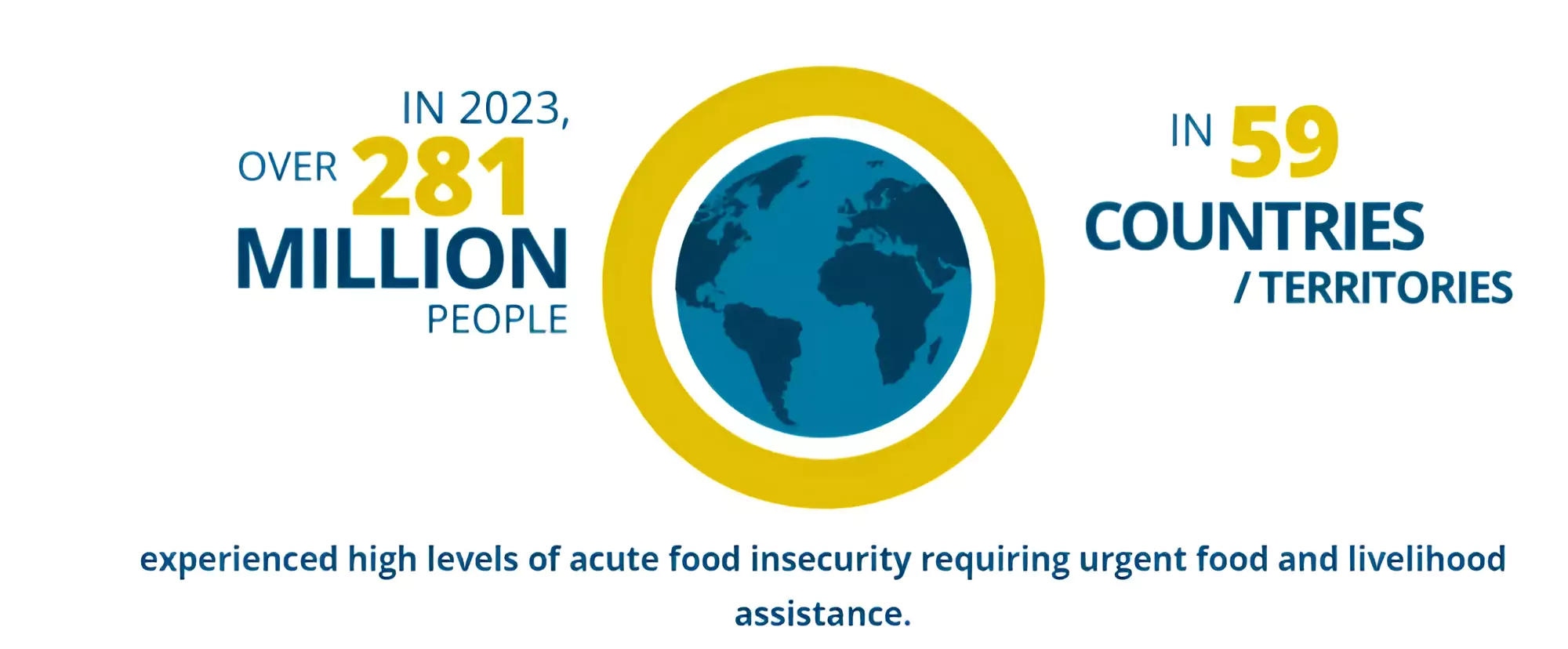
Rise in Acute Food Insecurity: Overall, 1 in 5 people assessed were in need of critical urgent action.
- The overall share of the analysed population facing high levels of acute food insecurity was marginally lower than in 2022, but still higher than pre-COVID-19.
- Since the first report by the Global Food Crisis Network covering 2016, the number of food-insecure people has risen from 108 million to 282 million.
- Meanwhile, the share of the population affected within the areas concerned has doubled 11 percent to 22%.
- 36 countries have been consistently featured in the GRFC analyses since 2016, reflecting continuing years of acute hunger, and currently representing 80% of the world’s most hungry.
- There has also been an increase of 1 million people facing Emergency (IPC/CH Phase 4) levels of acute food insecurity across 39 countries and territories, with the biggest increase in Sudan.
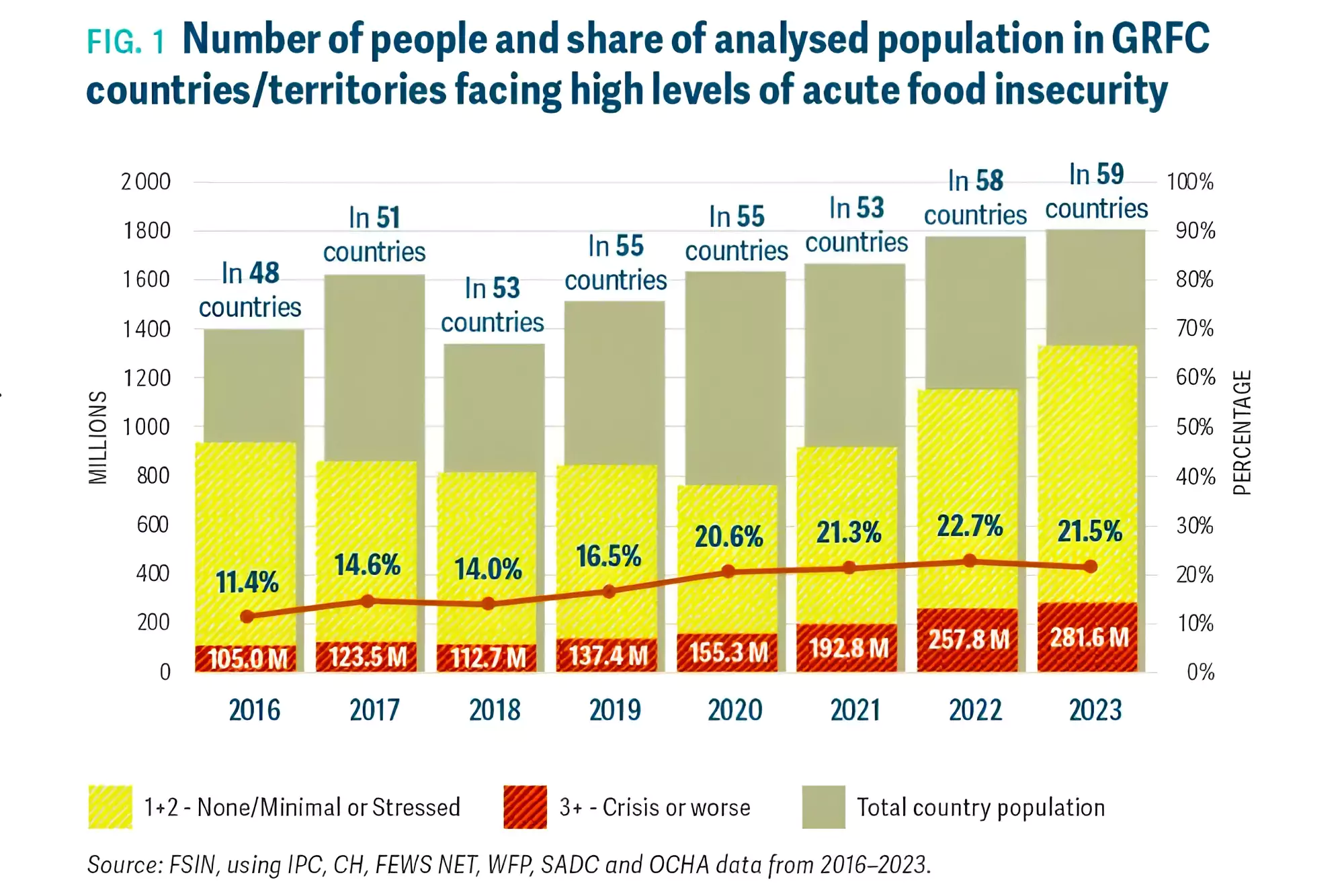 Year-on-year Increase: It was mainly explained by increased analysis coverage, as well as deterioration in some countries / territories outweighing improvements in others.
Year-on-year Increase: It was mainly explained by increased analysis coverage, as well as deterioration in some countries / territories outweighing improvements in others.
- More geographical areas experienced “new or intensified shocks” while there was a “marked deterioration in key food crisis contexts such as Sudan and the Gaza Strip.
- Acute food insecurity deteriorated in 12 countries with comparable data between 2022 and 2023, where 13.5 million more people needed urgent assistance, mostly in Sudan.
- Regional Impacts: Food insecurity worsened around the world in 2023, with some 282 million people suffering from acute hunger due to conflicts, particularly in Gaza and Sudan.
- The Gaza Strip became the area with the most severe food crisis in the last eight years.
- Sudan is facing one of the worst food crises in the world, with almost a third of the population in need of emergency food aid.
- Prolonged major food crises are ongoing in Afghanistan, the Democratic Republic of Congo, Ethiopia, Nigeria, Syria and Yemen.
- Worsening conditions in Haiti were due to political instability and reduced agricultural production.
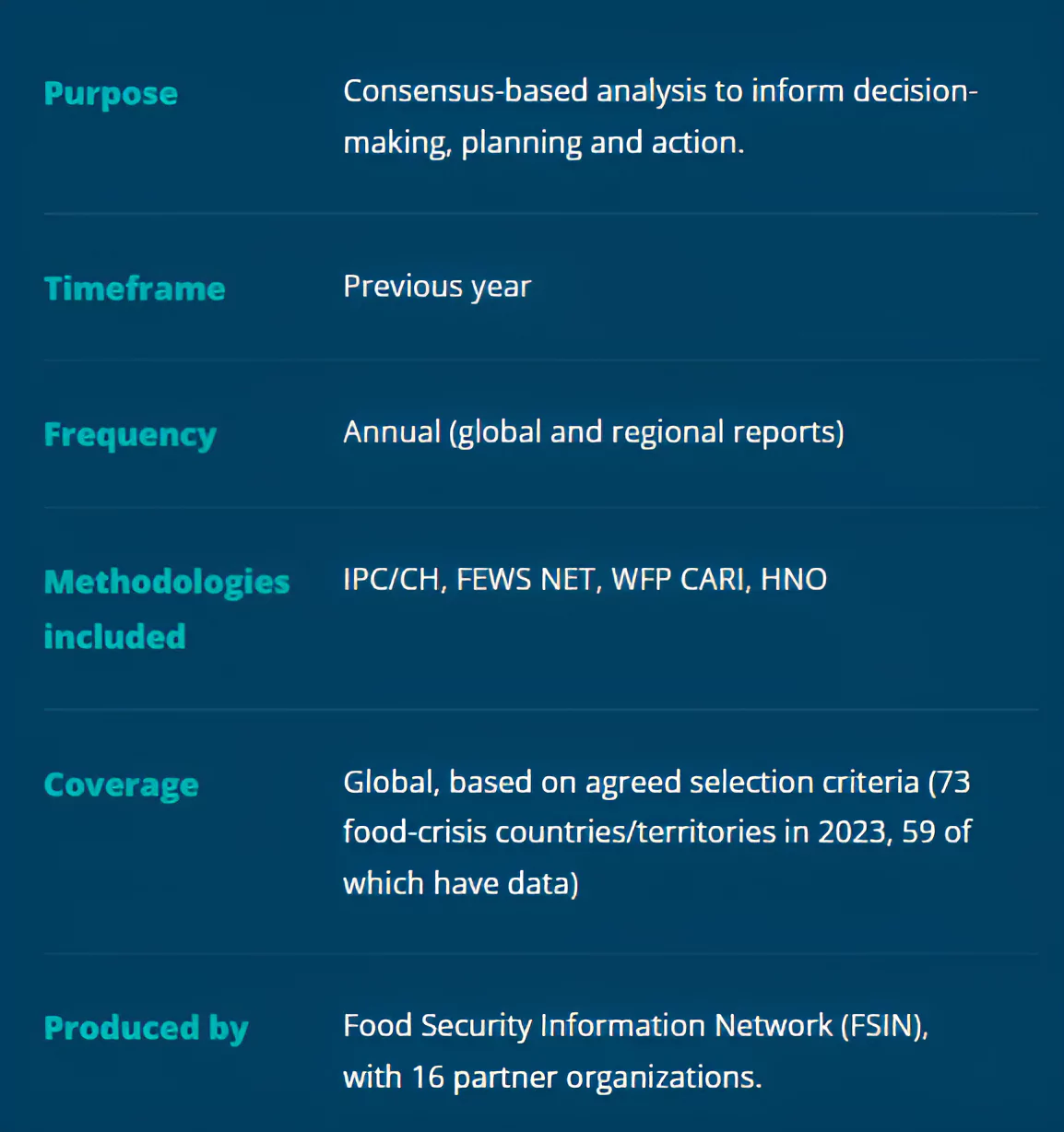 Interconnection between Displacement & Acute Food Insecurity: In both Sudan and Gaza, the number of forcibly displaced people reached 90 million in the 59 countries, the highest in eight years of GRFC reporting, highlighting the high correlation between displacement and acute food insecurity.
Interconnection between Displacement & Acute Food Insecurity: In both Sudan and Gaza, the number of forcibly displaced people reached 90 million in the 59 countries, the highest in eight years of GRFC reporting, highlighting the high correlation between displacement and acute food insecurity. -
- Sudan became the world’s biggest internal displacement crisis.
- By the end of 2023, almost 80% of the population of the Gaza Strip was internally displaced.
- Starvation: In 2023, more than 705,000 people were at the Catastrophe (IPC/CH Phase 5) level of food insecurity and at risk of starvation, the highest number in the GRFC’s reporting history.
- Famine: The current situation in the Gaza Strip accounts for 80% of those facing imminent famine, along with South Sudan, Burkina Faso, Somalia and Mali.
- Funding: It is not keeping pace with need.
- Also, the costs of distributing aid have risen.
- Observed Improvement: The situation improved in 17 countries in 2023, including the Democratic Republic of Congo and Ukraine, resulting in 7.2 million fewer people facing high levels of acute food insecurity.
Food Security
World Food Summit of 1996: It defined food security as “when all people, at all times, have physical and economic access to sufficient, safe and nutritious food that meets their dietary needs and food preferences for an active, and healthy life”.
-
Dimensions:
- Availability: This refers to the presence of food within a country, including food produced domestically, imports, and stock stored in government granaries.
- Accessibility: It ensures that food is within reach of every individual without discrimination and everyone has the opportunity to obtain the food they need.
- Affordability: It means having enough financial resources to purchase sufficient, safe, and nutritious food to meet one’s dietary requirements.
-
Need & Significance:
- To achieve Sustainable Development Goal: Food security advances sustainable development by achieving one of its main goals (Goal 2- Zero Hunger) and supporting other related goals, such as poverty reduction, good health, gender equality, and environmental sustainability.
- Others: Food Security is required for a good Health and Nutrition, Economic & Social Stability, Environmental Sustainability, National Security, Human Dignity and Equity and other factors.
-
India’s Taken Initiatives:
- Pradhan Mantri Garib Kalyan Anna Yojana
- Eat Right India Movement
- POSHAN Abhiyan
- Pradhan Mantri Matru Vandana Yojana
- Food Fortification
- National Food Security Act, 2013
- One Nation One Ration Card
- Atmanirbhar Bharat Rozgar Yojana
- Pradhan Mantri Kisan Samman Nidhi
- Intensified Mission Indradhanush 3.0 Scheme
|
Key Drivers of Food Crises
Intensifying conflict and insecurity, the impacts of economic shocks, and the effects of extreme weather events are accelerating the acute food insecurity.
- Concerning Impacts: These interlinked drivers are exacerbating food systems fragility, rural marginalization, poor governance, and inequality, and lead to massive displacement of populations globally.
- The protection situation of the displaced population is additionally impacted by food insecurity.
Enroll now for UPSC Online Classes
Key Drivers of Food Crises
|
Impact Observed
|
| Conflict/Insecurity |
- It remained the primary driver affecting 20 countries with nearly 135 million people in acute food insecurity, almost half of the global number.
- Sudan faced the largest deterioration due to conflict, with 8.6 million more people facing high levels of acute food insecurity as compared with 2022.
|
| Extreme Weather Events |
- These were the primary drivers (second most significant factor) in 18 countries where over 77 million people faced high levels of acute food insecurity, up from 12 countries with 57 million people in 2022.
- In 2023, the world experienced its hottest year on record and climate related shocks impacted populations.
- The El Nino event and climate change-related weather phenomena made 2023 the hottest year on record.
- El Nino conditions, currently prevailing over the equatorial Pacific region, are generally responsible for warmer temperatures in many places around the world, including in India.
|
| Economic Shocks |
- These primarily affected 21 countries where around 75 million people were facing high levels of acute food insecurity.
- It is due to their high dependency on imported food and agricultural inputs, persisting macroeconomic challenges, including currency depreciation, high prices and high debt levels.
|
India’s Response to Global Food Crisis
- India’s Traditional Belief: India sees the world as one family and that is linked to its Vedic tradition of Vasudhaiva Kutumbakam — underlining its relevance not just for global peace, cooperation, environment protection but also for humanitarian response including rising global hunger and leaving no one behind.
- India’s humanitarian food assistance to the people of Afghanistan, through the United Nations Food Programme (where half of the population needs urgent food assistance to avert a famine) is an example of its commitment and commendable steps towards humanitarian crises.
- India’s Mainstreaming of Millets: India launched the ‘Millets and Other Ancient Grain International Research Initiative’ (MAHARISHI).
- It facilitated synergies and collaborations between nations, research institutes and civil society organizations to achieve Zero Hunger (SDG2).
- India’s role in declaring 2023 as the International Year of Millets by the United Nations General Assembly is expected to create international recognition for these nutrient-rich crops.
- Public Stockholdings of Food Grains in the WTO: During the WTO 13th Ministerial Conference (MC13), India has been vocal about the need for a permanent solution on public stockholding for food security purposes, allowing developing countries to subsidise agricultural production without facing trade sanctions.
-
- India is deeply concerned about the impact of agricultural subsidies and domestic support measures adopted by developed countries on its farmers’ livelihoods and food security.
Way Forward to Combat Global Food Crisis
- Urgent Response: This food crisis demands an urgent response. Using the data in this report to transform food systems and address the underlying causes of food insecurity and malnutrition will be vital.
- An Integrative Approach: The Global Network Against Food Crises urgently calls for a transformative approach that integrates peace, prevention and development action alongside at-scale emergency efforts to break the cycle of acute hunger.
- Without peace and protection, people will continue to face a lifetime of hunger and the most vulnerable will starve.
- For 2024, progress will depend on the end of hostilities.
- Long-term Investment: Tackling persistent food crises requires urgent long-term national and international investment to transform food systems and boost agricultural and rural development alongside greater crisis preparedness and critical life saving assistance.
- Humanitarian Approach: More equitable and effective global economic governance is imperative and must be matched with government led plans that seek to reduce and end hunger.
- The aid could rapidly alleviate the crisis in Gaza or Sudan, once humanitarian access to the areas is possible.
- A Global Commitment & Action: The Global Network Against Food Crises offers to leverage its unparalleled knowledge of hunger in the most fragile countries to strengthen the linkages and build coherence where possible between these various global initiatives to ensure innovative and concrete impact for those affected by food crises.
- The international community has made a range of bold commitments including through the recent G7 and G20 initiatives to tackle rising acute food insecurity.
- Examples: The G20 Deccan High-Level Principles on Food Security and Nutrition 2023.
- In 2022, the G7 leaders announced an additional US$ 4.5 billion to the United Nations World Food Programme (WFP) to protect the world’s most vulnerable people from hunger and malnutrition.
- The United Nations World Food Programme is the world’s largest humanitarian organization, saving lives in emergencies and using food assistance to build a pathway to peace, stability and prosperity for people recovering from conflict, disasters and the impact of climate change.
Enroll now for UPSC Online Course
Also Read: World’s Largest Grain Storage Plan In Cooperative Sector
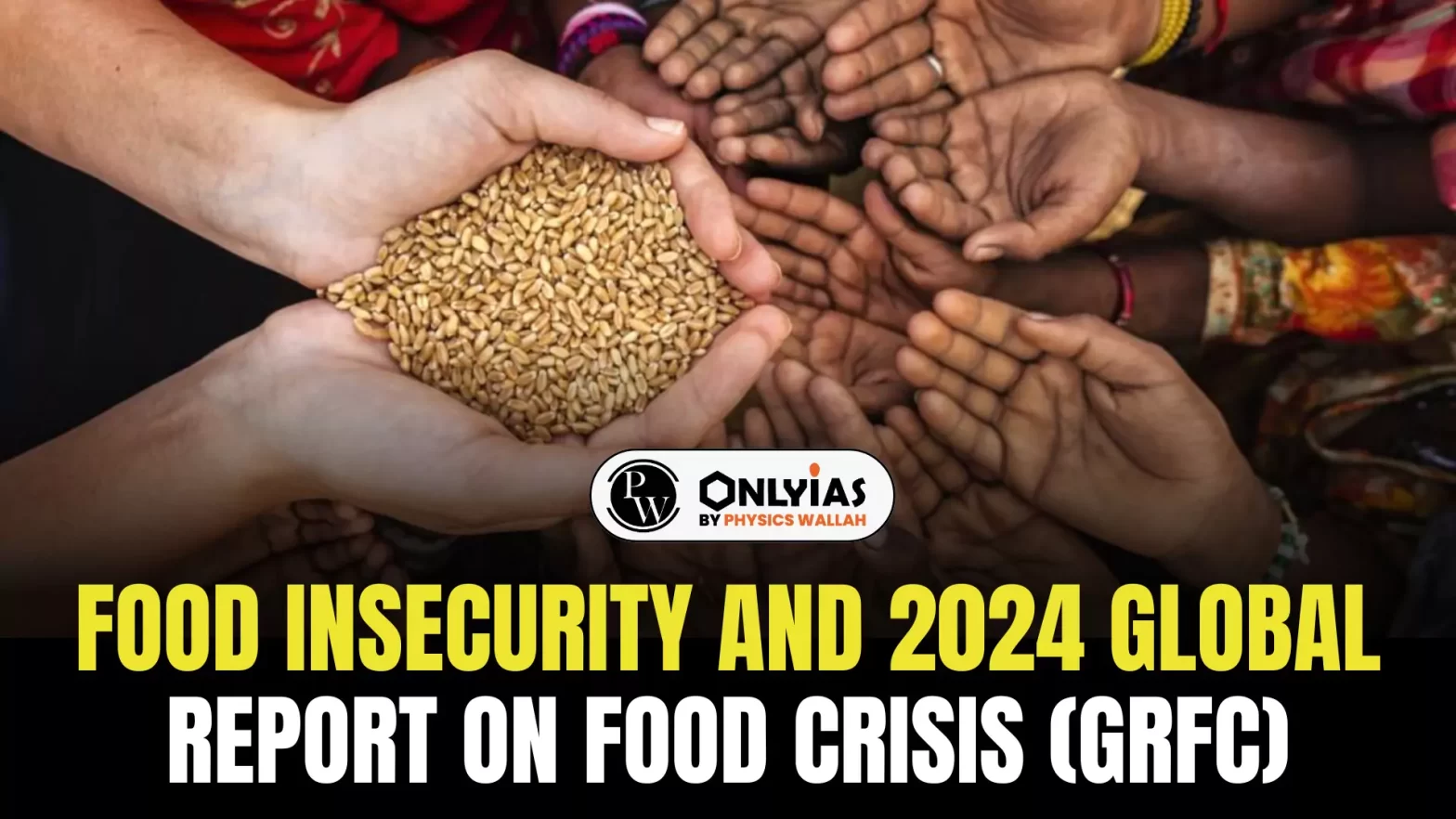


 Year-on-year Increase: It was mainly explained by increased analysis coverage, as well as deterioration in some countries / territories outweighing improvements in others.
Year-on-year Increase: It was mainly explained by increased analysis coverage, as well as deterioration in some countries / territories outweighing improvements in others.
 Interconnection between Displacement & Acute Food Insecurity: In both Sudan and Gaza, the number of forcibly displaced people reached 90 million in the 59 countries, the highest in eight years of GRFC reporting, highlighting the high correlation between displacement and acute food insecurity.
Interconnection between Displacement & Acute Food Insecurity: In both Sudan and Gaza, the number of forcibly displaced people reached 90 million in the 59 countries, the highest in eight years of GRFC reporting, highlighting the high correlation between displacement and acute food insecurity. 